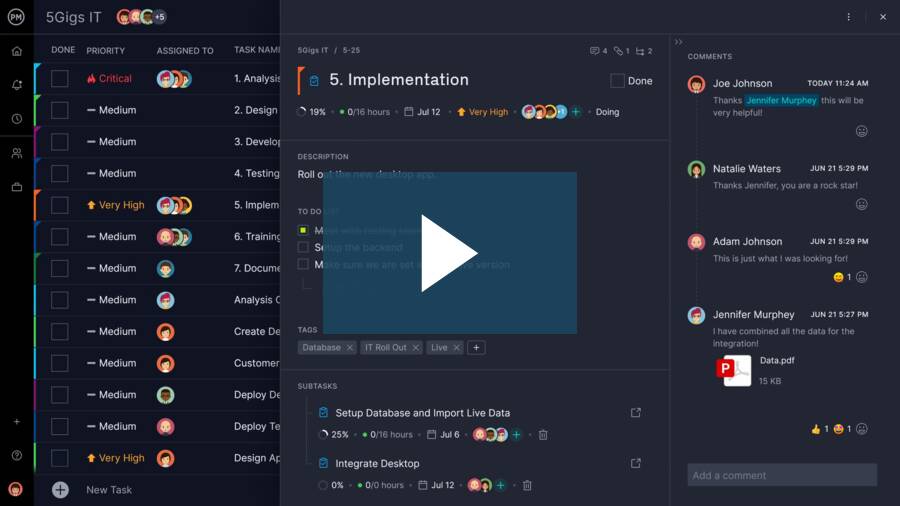- Working from Home vs. Working at the Office
- What Is Work From Home Software?
- Benefits of Work from Home Software
- Must-Have Features of Work from Home Software
- Using ProjectManager.com to Manage Work from Home
- How to Work From Home: Best Practices
- Benefits of Working From Home
- Challenges of Working From Home
- Work From Home Apps
- Work From Home Tips
- Work From Home Resources
People who work from home used to be like exotic animals. You heard about them, of course, but you never actually saw one in the wild. If you were lucky enough to encounter someone who worked from home, a barrage of questions followed. “Don’t you get lonely? Do you just sit in your underwear all day? What did you do to your boss to become exiled from the office?”
But over time, as technology advanced and society changed, working from home became more desirable. People wanted the flexibility to balance their life and work, and to set their own hours where possible. Plus, organizations realized that there was a wealth of talent waiting for them outside the radius of commuting distance.
Then in the spring of 2020, everything changed. The COVID-19 / Coronavirus pandemic hit, and “work from home” became the reality for most office workers around the world. CEOs who had been ignoring the benefits of a home workforce were suddenly forced to test a new remote way to work with their companies.
Work from home software, like online project management software and virtual conferencing platforms, made this transition possible. ProjectManager, for example, helps teams plan projects, manage tasks and collaborate from anywhere with an internet connection.

Today, working from home can be considered a booming trend. In fact, it’s saving many industries, keeping them productive and creating efficiencies to help their bottom line.
Working from Home vs. Working at the Office
Working from home is not the same as working in an office: there are a number of differences. The most obvious being that you have to find a way to turn your personal space into a productive workspace. That’s not as easy as it sounds.
The office environment is designed to eliminate distractions; but the home is a different animal. It’s set up for a completely different end, so you have to repurpose a piece of it to fit into a structure that permits you to work uninterruptedly. This often requires some creativity.
Not everyone lives in spacious quarters that allow for a home office in a dedicated room. That home office might have to be set up on the dining room table. At work, you might have to contend with a talkative coworker or loud music, but at home, there are distractions at every turn. It’s not so easy to eliminate those distractions—kids, comfy beds, laundry— but it’s possible.
There are many ways to work better from home. Read on to get those tips. But the most important tool for the home worker is software. There are a number of different online tools that can help, but dynamic project management software is at the top of that list.
What Is Work From Home Software?
Work from home software is a collection of tools that help connect teams and managers. It has features to facilitate collaboration and give teams the independence they need to manage their workload, all while offering managers transparency into their work.
Teams that work from home need tools to help them work with teammates that might be in different regions and timezones. That calls for easy sharing of data, notifications and clear communications to keep their work flowing uninterrupted.
Managing remote teams that are distributed throughout the country or world creates challenges that work from home software solves. Assignments, priority and directions are easily delivered. Workloads can be viewed and balanced, and timesheets are automated. Microsoft Project is one of the most commonly used project management software, but it has major drawbacks that make ProjectManager a much better alternative to manage teams remotely.
Benefits of Work from Home Software
Having software that connects your team to their work, and you to your team, is essential for remote work. Having a tool that can keep teams updated on the priority of their tasks and managers on the team’s progress is how the project stays on schedule.
Being able to offer teams multiple project tools that allow them to work how they want adds to their productivity. But that’s only one reason to use work from home software. Here are some more:
- Get a Real-Time Collaborative Platform
- Create Plans and Schedules Online
- Manage Tasks and Keep Teams Productive
- Stay Updated With Email and In-App Alerts
- Access Tool Anywhere, Anytime
- Work On a PC or Mac
- Track Your Team’s Logged Hours on Timesheets
- Keep All Your Files in One Central Hub
Must-Have Features of Work from Home Software
To make sure the work from home software you choose is going to help teams and managers work better together, it should have at least the following features.
Connect Teams For Greater Productivity
Work is rarely a solitary activity. Teams need to stay in touch with each other, which is why having a collaborative tool is so important. You need real-time communications, the ability to comment at the task level and manage their work.
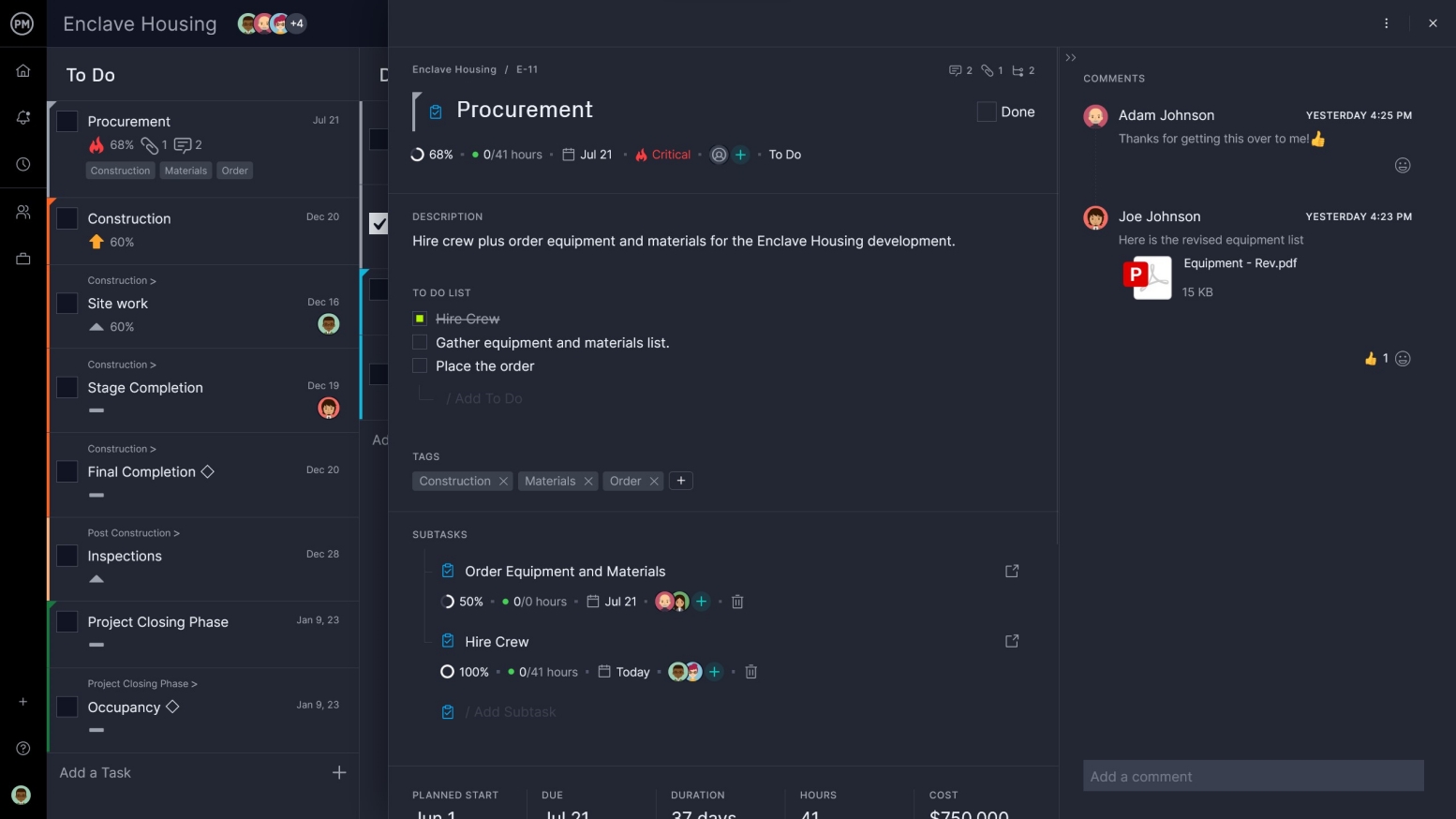
Keep Track of You and Your Team’s Work
To keep the work moving, you need features that will allow you to assign tasks and track their progress. A kanban board is a visual tool that organizes your backlog and gives teams the power to manage their workflow, while providing managers transparency to allocate resources.
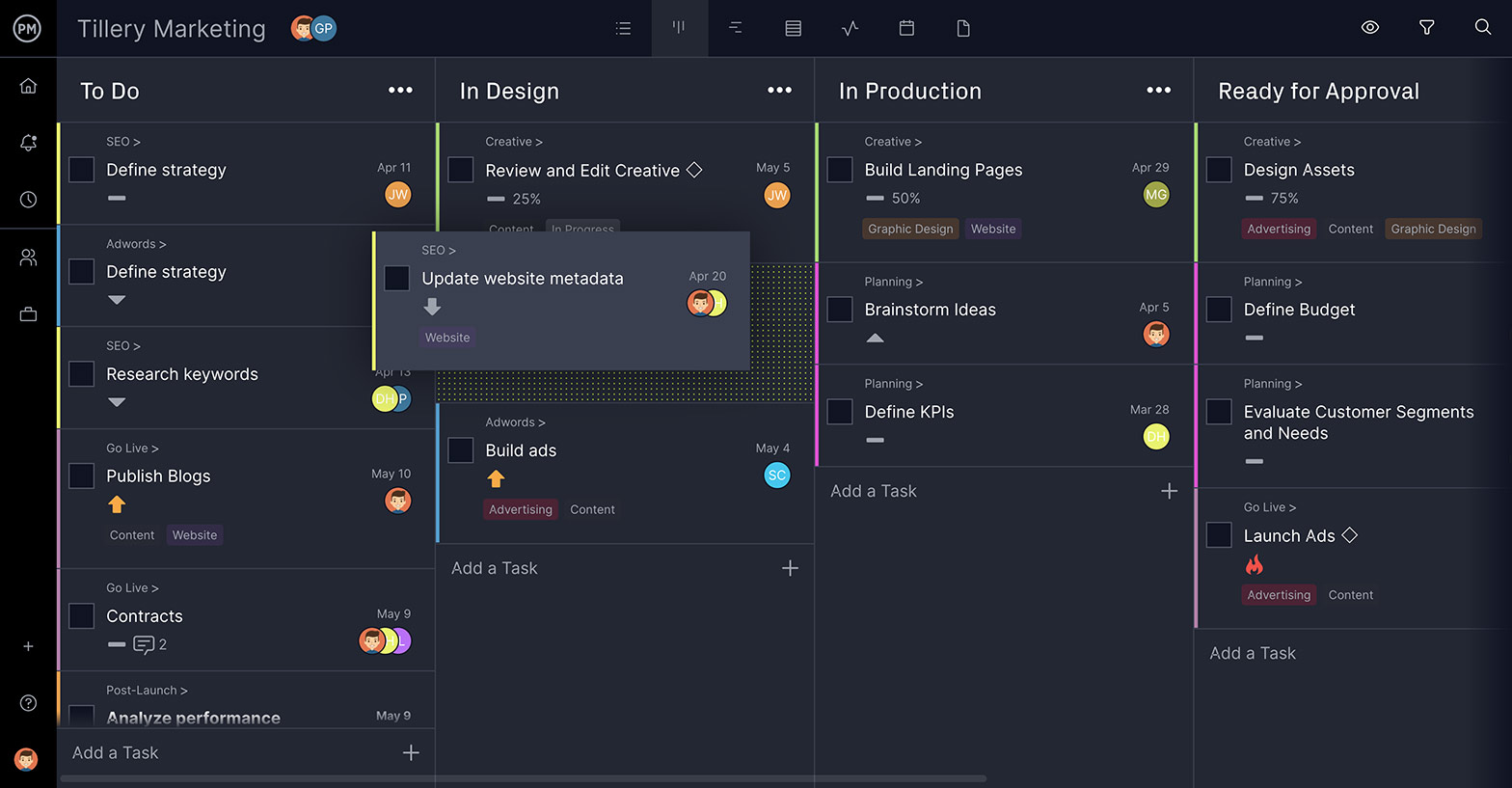
Know Your Team Is Working As Planned
One of the fears of managing teams that work from home is that they’re not focused on tasks. Timesheets are a feature that streamlines the payment process for them and gives managers a view into the hours they’ve logged for each task.
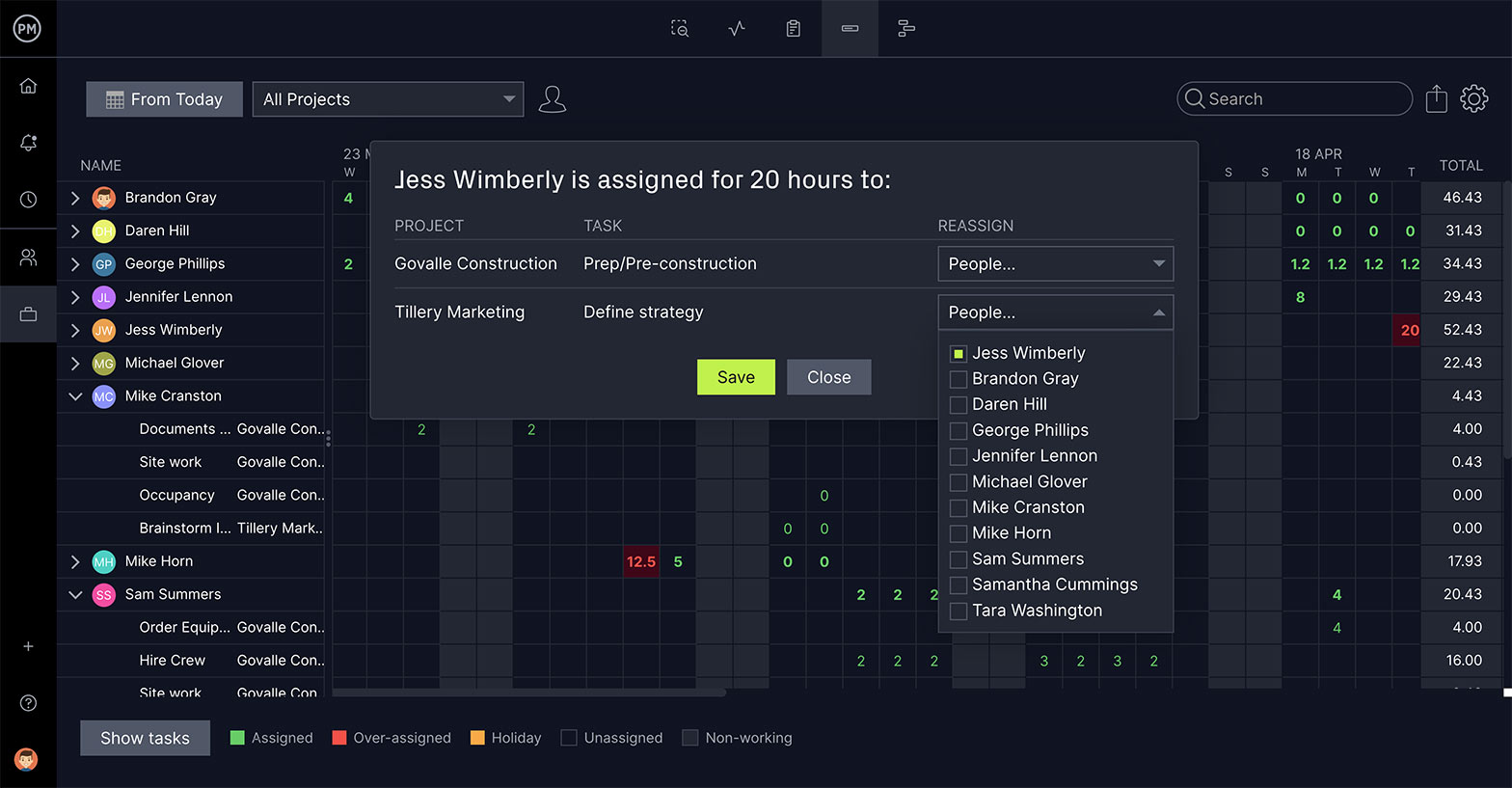
Hold All Your Files In One Place
Working from home shouldn’t mean that teams are unable to access important documents- whether they’re for a project or administrative duties. Having a tool with unlimited file storage gives you a central hub to keep everything together and readily accessible.
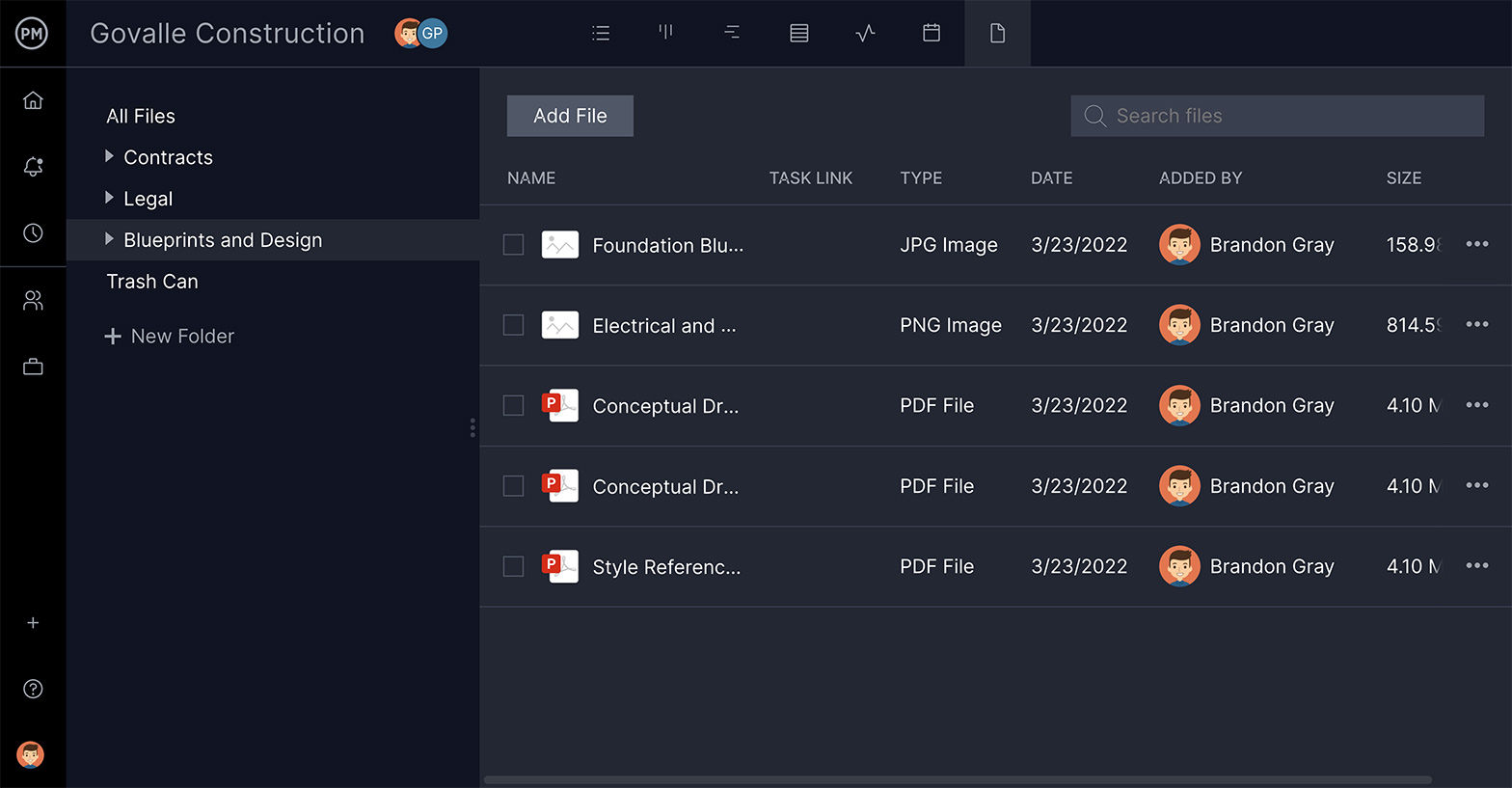
Stay Updated On What’s Going On
Connecting teams that work from home means having a channel open that notifies them when tasks are updated or teams are commenting on their work. A cloud-based software can trigger email alerts in real-time. Having in-app notifications also helps to keep teams updated.
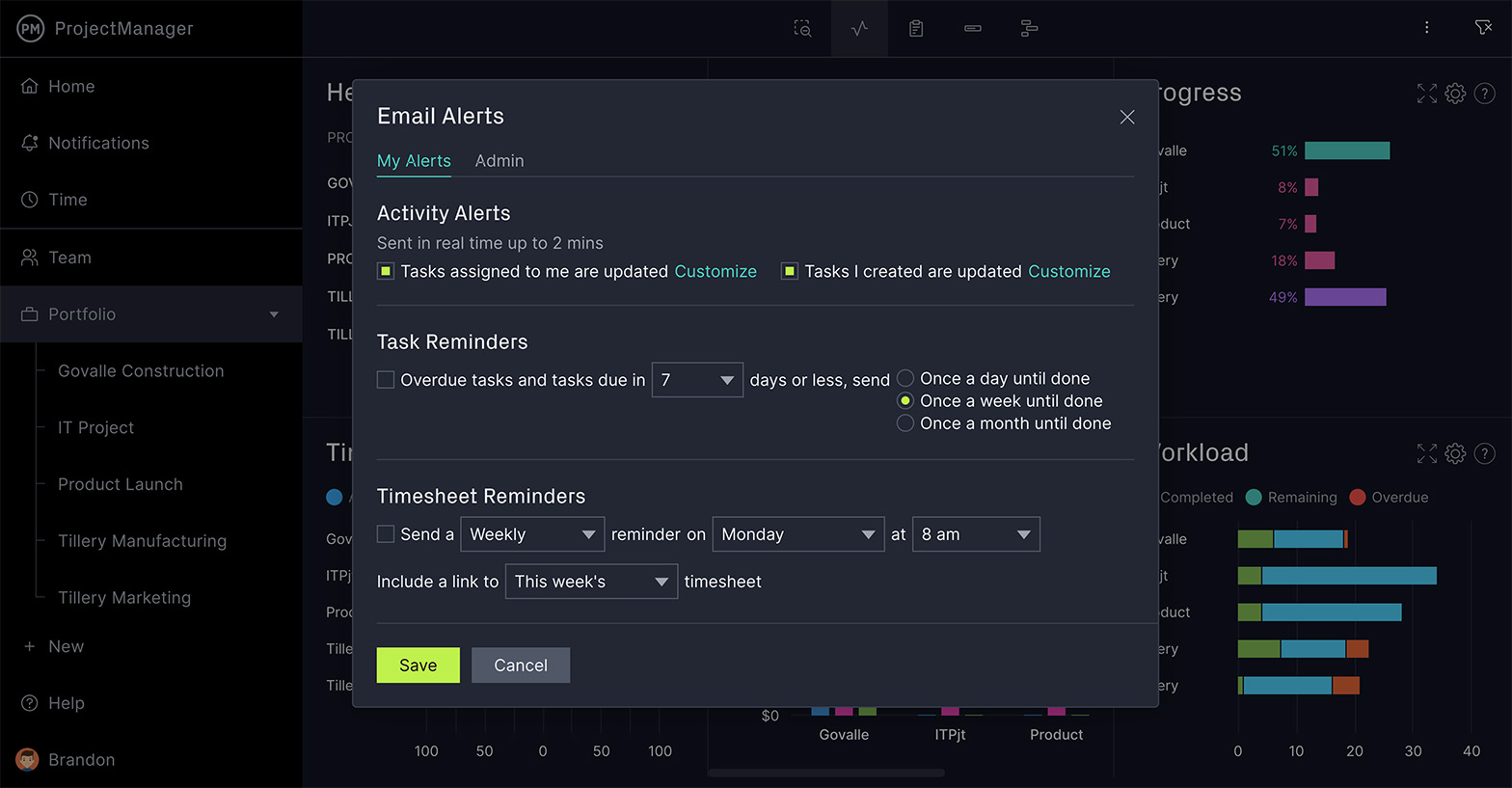
Get Details on Your Team’s Performance
When your teams aren’t working next to you it can be hard to know what they’re doing and how you can help them. Reports can provide deep insights into their workload, timesheets and progress, giving you the tools to adjust resources and better serve them.
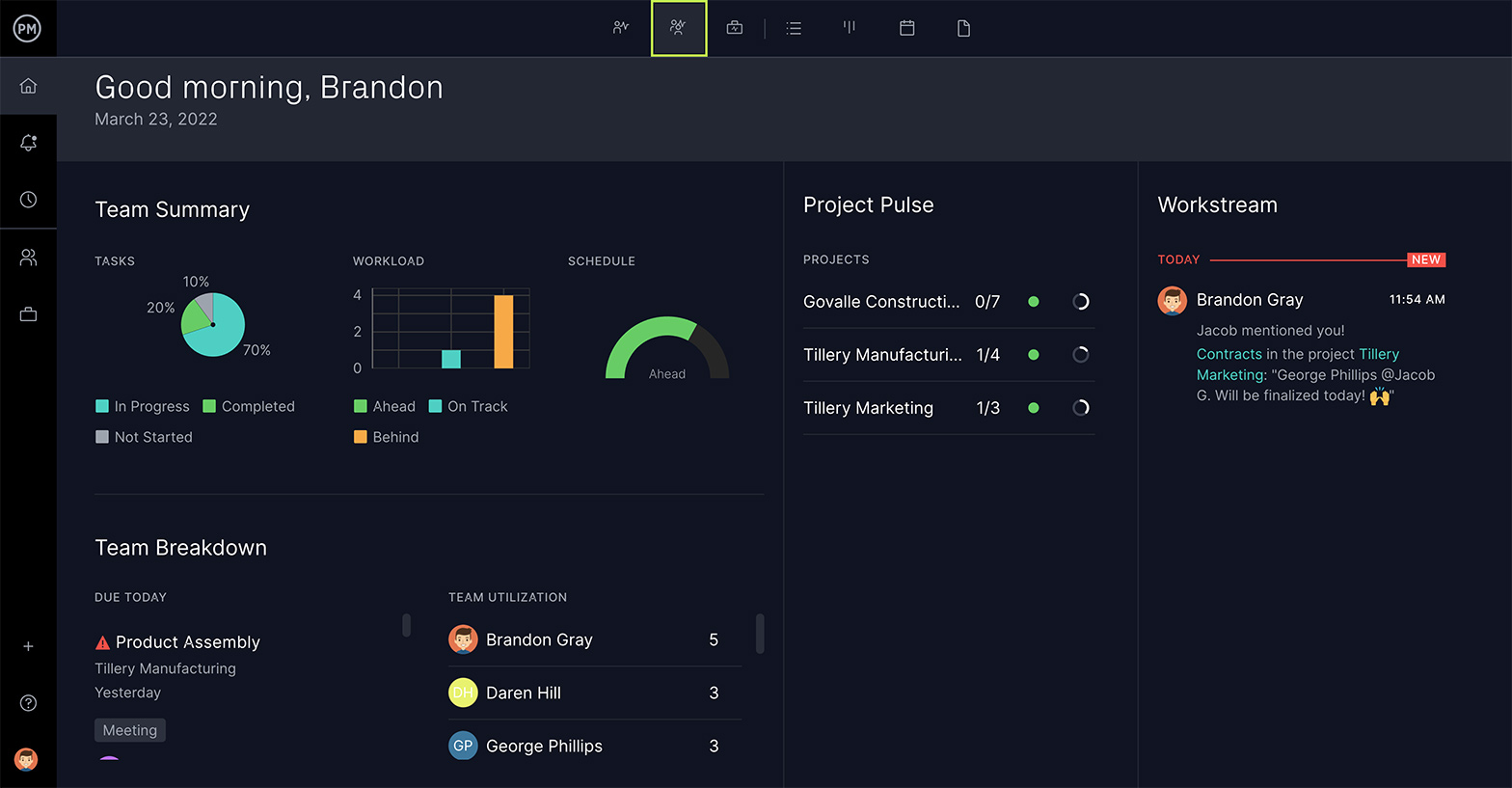
Using ProjectManager to Manage Work from Home
Even if you get in the right mind and spirit, you still need work from home software to give you the connectivity necessary to get your job done. There are tasks to manage and progress to track in order to stay productive.
ProjectManager is an award-winning online project management software that has been helping remote teams work better together for years. Our cloud-based software is always accessible online and is packed with features that make remote work possible.
Working from home demands a thorough task management process. You should be able to control your workflow and stay focused, while keeping track of your tasks, even if they fall across multiple projects. That’s a lot to ask of one software, but ProjectManager has your back. Let’s go through how, step by step.
1. Import Task List
Task lists are the lifeblood of any project, whether in the office or at home. They feed you work for the day, week or even month. Having a task list is what makes a large or small project doable.
To help you get up and running quickly, ProjectManager makes it easy to import your existing work from anywhere. Simply export your tasks to a spreadsheet and then import it into ProjectManager.
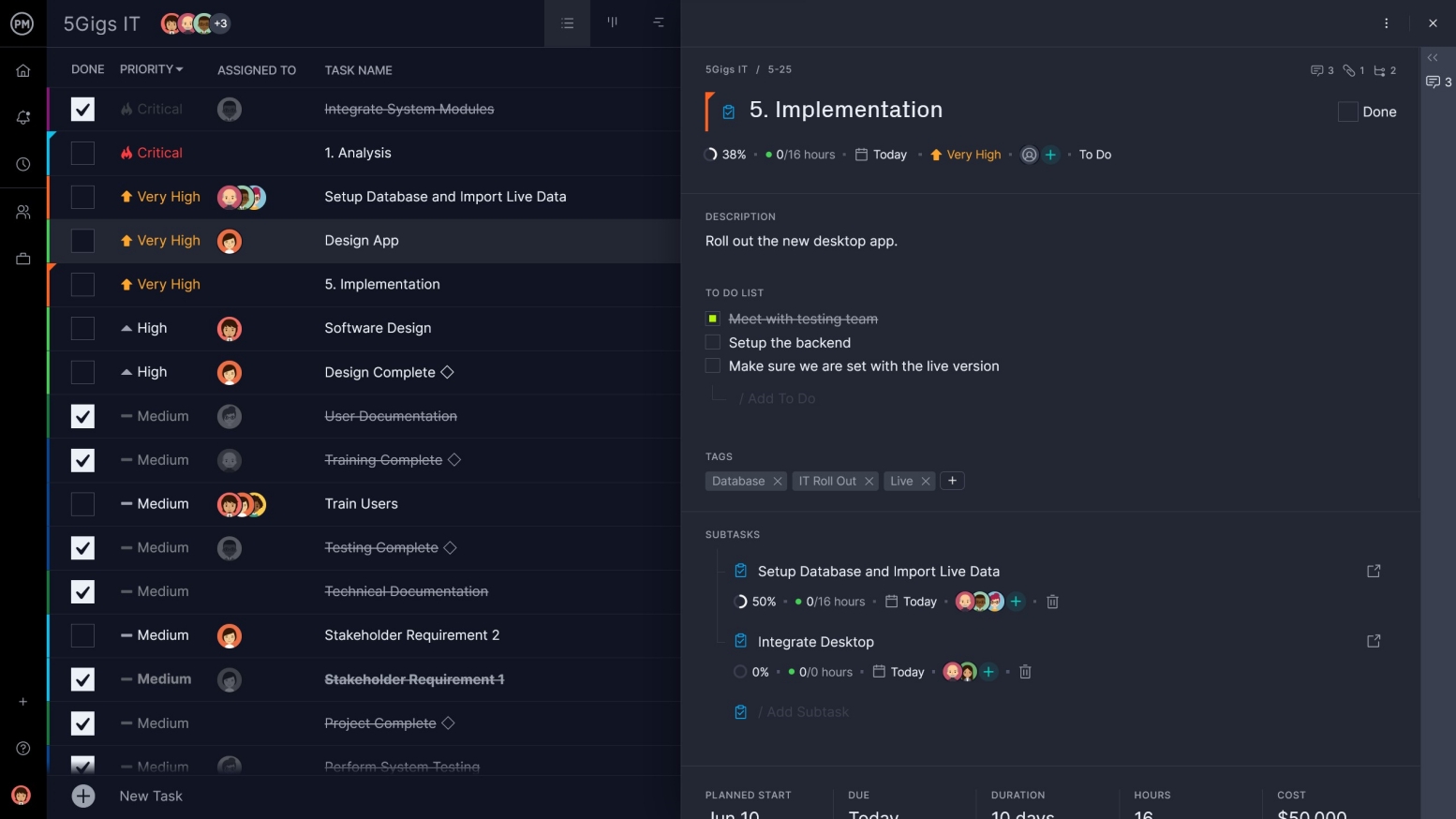
2. Choose Your Project View
Working from home means working how you want. You can listen to music or keep things quiet. ProjectManager understands that you also have a preferred way to manage your tasks.
Once your tasks are in ProjectManager, you now have multiple ways to view them. There’s a kanban board to visualize workflow, a task list to keep it simple, a calendar view for important dates or a Gantt chart to see the whole project across a timeline.
Related: Gantt Chart Guide
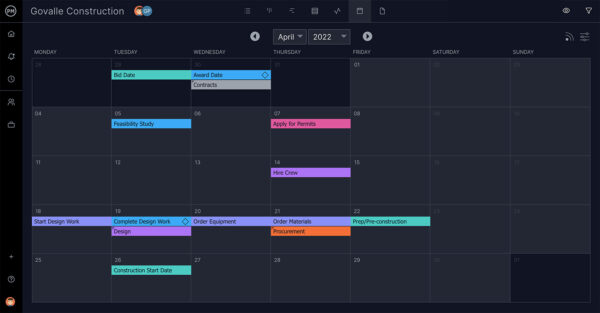
3. Make Assignments
Your manager can assign you tasks, adding comments and files for direction, but you can also assign yourself work. This gives you power over your tasks. You can also collaborate with other team members, assign them tasks or simply tag them for quick feedback.
Each task opens up a window that gives users the ability to set deadlines, add comments, create personal to-do lists, attach files, set priority levels and make tags so the task is easier to find.
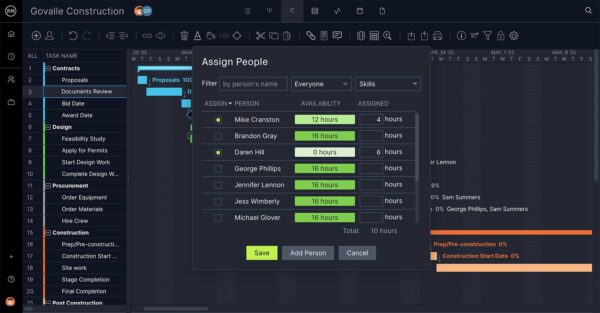
4. Customize Your Workflow
Every organization works a little bit differently, especially when people are working from home. Software should be flexible to accommodate these differences and create workflows. ProjectManager provides a customizable kanban board view for this purpose.
From the kanban board project view, you can set up your own personal workflow or a shared one with the team. Column headings can be customized. Tasks are cards, which are dragged and dropped from column to column.
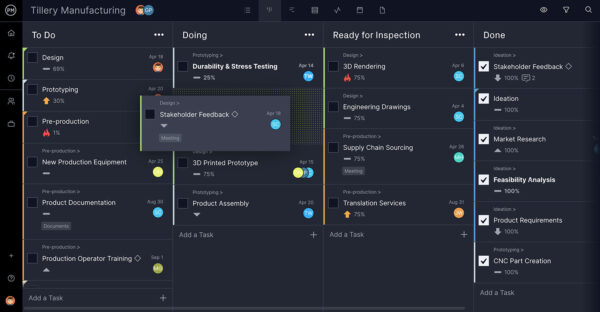
5. Track Your Progress
Knowing if you’re on schedule or not is critical to managing your work when you’re separated from your team. You need a tool that can monitor and track your progress, so you’re alerted if things aren’t going according to plan.
ProjectManager gives you the tools to monitor all of your work. A real-time dashboard gives you a high-level view of your progress in easy-to-read charts.
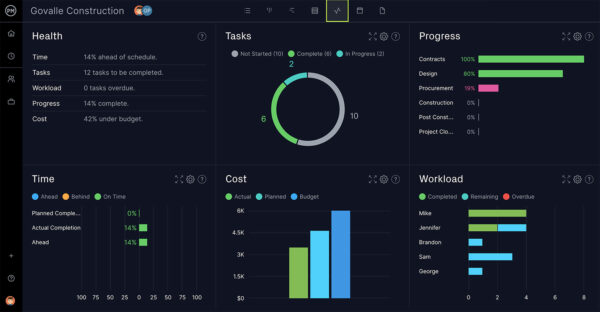
This software also helps to clean up all of your random to-do lists by giving you a personal command center called “My Work.” Do you have a computer screen obscured by layers of Post-It notes?
With ProjectManager there’s a space dedicated to only what’s assigned to you. From this page you can update your tasks, progress and even assign tasks to yourself and others. You can manage those tasks in multiple views: list, board or calendar. Whatever works for you.
Ready to get started? Sign up for a free 30-day trial of ProjectManager
Now that you got a usable tool, let’s focus on best practices.
How to Work From Home: Best Practices
Every working from home job is unique, but they share many of the same challenges. The following are some tips that can help you do your job better and feel better doing it.
Stay Motivated
This is a big one. Sometimes motivation, creative thinking and innovation fall behind in a work from home environment. This can be due to a lack of routine or discipline.
It can be hard to get out of bed when you’re just a few steps away from your home office. Therefore, have a home office that is as separated from where you sleep. It’s imperative that you don’t sleep in. Wake up early, shower and get dressed. This puts you in the work frame of mind. Create a regular morning routine; a routine is a way to develop the discipline you need to stay motivated.
But, don’t forget to add breaks to your routine. Get up and take a walk. Don’t neglect to have lunch either. If you must, set up a rewards system, such as a treat between meals once you get a certain amount of work done.
Be Productive
It’s difficult for most to maintain productivity when you don’t have a manager or coworkers around.
To solve this, don’t start your work in spurts. Set up a work schedule and start at the same time each day. Many people find it helpful to use time blocking in order to segment each day into different types of work.
Stay On Task
Avoid procrastinating and avoid getting distracted by the television or the refrigerator. Yes, that’s easier said than done. Therefore, to avoid procrastination give yourself a break after that work period to do something you like. It’ll recharge your batteries for the next long haul.
Another way to say on task is by making yourself to-do lists, such as what must be done by lunchtime and by the end of the day. This gives you goals and deadlines, which are also great remedies for keeping procrastination at bay.
Don’t Neglect Yourself
Health is a major consideration in any job. But when you’re working from home that responsibility falls on your shoulders. We’ve talked about taking breaks and rewarding yourself, which covers mental health, but don’t forget that you’re in a body and that body was never intended to sit at a desk all day tapping away at a keyboard.
Ergonomics help. If you use a laptop, get a separate keyboard. Then get a stand to elevate your screen to eye level. But these fixes only go so far. You can get yourself a nice chair, one that keeps you sitting in good posture, but even that will not save your back.
Get up, stretch and take a walk—maybe during your lunch break. Even just getting up from your desk every half-hour to get a drink of water is helpful. Speaking of water, stay hydrated and eat healthy. Keep those empty calories at a distance.
Be Aware of Burnout
Burnout is a danger lurking in every modern office, even if your office is your home. The dark side of motivation and productivity is that people overestimate their capacity and push themselves to the breaking point. Once that happens, it can take time to recover from workplace stress, so it’s important to set up protocols that stop you before the crash.
One way is to maintain your boundaries. That means when working, work, but when you’re off the clock don’t jump to answer that email or text from work.
Knowing how you work and keeping boundaries will stop burnout from exhausting you. Are you a morning person? Then get your heavy lifting done then. If you find the afternoon is more productive, then do less mentally challenging tasks early.
Benefits of Working From Home
Probably the number-one thing people complain about when they have to go into an office is just that, going into the office. In most metropolitan areas, commuting adds hours to one’s day. People often decide where they’re going to live based on the commute. Working from home turns miles into feet.
While an office might be set up to facilitate work, your home has some major benefits for productivity too.
Fewer Distractions
For the most part, it’s quieter. There are fewer people there. Even if you have kids, if they are of a certain age, most of their day will be spent in school. It’s like your home is a cone of silence. You’re comfortable there and are likely to work longer and take fewer breaks.
More Labor Options
Working from home is often used as an example of how corporations can mine talent outside their geographic footprint, but the same is true for the worker. A person working from home is able to work for anyone, anywhere. Smaller companies and startups that might not have the capital to invest in office space can funnel that funding into paying for skilled labor like yourself.
Save Money
Businesses can save a lot of money not having to set you up in an office. They might pay for your internet or even supply you with the equipment you need, but much of that will be online, saving them from costly installation. The extra money is going to help their bottom line and it could go to you as a raise or other incentives.
Flexibility
Not all people who work from home have the luxury of setting their own hours, but even fewer who work in an office are able to do that. Some jobs will ask people working from home to schedule their time to match that of those working in the office. However, one of the perks of working from home is that, as long as the work gets done, many employers don’t care when you do it.
Comfort
While business casual has become the norm in many industries, people are still not encouraged to go to work in their pajamas. But, outside of a conference call, you can work in your robe if that’s comfortable. Not having to wear a suit and tie or high-heel shoes is very attractive to many people.
Challenges of Working From Home
While there are clearly many benefits to working remotely, there are also several challenges that can arise and cause problems with productivity and collaboration.
Limited Social Interaction
For many people, the lack of social interaction is akin to a prison sentence. This, naturally, will depend on whether you’re an introvert or an extrovert. There are ways around this; though most of them involve digital solutions.
Technology Problems
The next issue is technical. You are tethered to your office and coworkers through technology. If that technology is not delivering, then you’re going to get frustrated or worse.
Whether it’s a slow internet connection that makes a simple task take all day or it’s having poor tools that make it difficult to get your work done, you need to make sure that whoever is handling IT at your organization provides you with the right software solution.
Blurred Lines
With the invention of email and texting, the eight-hour day has mutated into a 24-hour work cycle. This modern problem is even worse for those who work from home. It can feel as if your day never ends.
You’re always on call, be that a phone, text, chat or any of the other communication devices set up to keep you in touch with your manager and the team. It can be hard to ignore that notice that comes in after hours, which can make you feel as if you’re not home but always in the office. This can hurt your work life balance.
Absence of Routine
The lack of structure can be depressing. As much as you might hate the alarm clock, showering and getting dressed for work, the commute, etc., these activities create a structure to your day. Structures are important. They are what hold us up and keep people productive.
Without a structure being forced on us by office hours, it’s easy to slip into a twilight zone where work and home life merge to the point that both falter.
Trust is Required
There are challenges for your employer, too. Working from home means that your manager must trust you, of course. But even with that in place, there must be a way to monitor and track progress. This can be difficult when you’re not in an office. You can’t as easily check in with your manager or get immediate feedback to keep your work moving forward.
Work From Home Apps
While a robust project management software like ProjectManager is key to a productive work from home office, there are other apps that complement it. Here are a few work from home apps that will complete your home office and help you overcome challenges.
G Suite
G Suite by Google Cloud is your office software anywhere you want it. All of Google’s productivity apps are collected under this virtual umbrella. From Gmail to Docs, Drive, Calendar and Meet, you have the tools you need to share data, organize meetings and keep on schedule.
myNoise
myNoise is something you can use at work and then after work when you need to get to sleep. It’s a white-noise machine that can also make rain sounds, unreal ocean and binaural beats. The app is free on the App Store or Google Play, but additional sounds will cost you.
This drowns out the noise of those who might share your house with you, as well as neighbors and sounds of traffic, construction, etc., so you can work or sleep. Just don’t mix them up.
Focus Booster
Focus Booster is a way to get more productive in your day by breaking it up into work and break sessions. There’s a dashboard that allows you to review reports and track your work. You can customize the session lengths to fit your schedule.
Work From Home Tips
Working from home has its challenges, but it fits a growing niche. Depending on the corporate culture where you work and your own temperament, working from home may not be ideal. But, it’s not going away.
If you find yourself either willingly or unwillingly working from home, let’s sign off with a few more tips to get the most out of your day:
- Spend five minutes each morning planning the day ahead and prioritizing your tasks.
- Respond to emails only at a specific time each day and allot only a certain amount of time to the work. These email management tools can help.
- Creative work, like drawing, music, etc., can be restorative, and you should allow yourself a period each day to just have fun.
- Daily standup meetings are a great way to start your day, meeting with your team and discussing what’s ahead and what everyone is working on. It’s good for work and helps teams bond.
- Exercise is important to your mental and physical well-being. Remember, exercising for only an hour is but four percent of your day. You can do it!
- Don’t let interruptions frustrate you. While you want to minimize them, they’re going to happen. Just accept the fact that you’ll be pulled away from your desk from time to time and enjoy it as a work break.
- Have lots of natural light in your work area and leave a window open, if you can, for the fresh air.
- Breathing exercises help reduce stress, such as square breathing (four seconds in, hold for four seconds, four seconds out and hold for four seconds, repeat).
- If you don’t use a white noise app, there’s always your record collection or streaming to create a productive soundtrack for your office.
- If you can regulate the temperature in your room to maximize your attention, do so. Some people work better in a cold room.
- Adopt a pet for companionship, and if you get a dog, walking them is an added bonus of exercise and fresh air. If you can’t get a pet, there are lots of cute animals to follow on Instagram.
- If your family or kids are home when you’re working, set guidelines for them, so they know when you can’t be disturbed.
Work From Home Resources
Articles
Start your free 30-day trial
Deliver faster, collaborate better, innovate more effectively — without the high prices and months-long implementation and extensive training required by other products.
Start free trial
